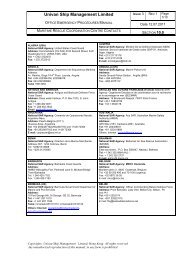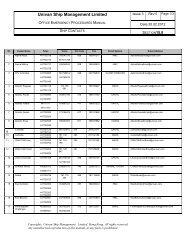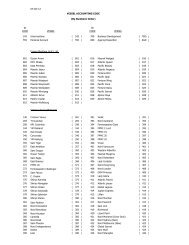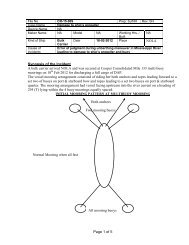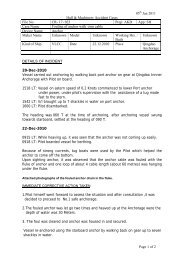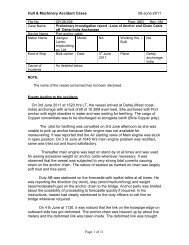Section: 11 CARGO OPERATIONS - Univan
Section: 11 CARGO OPERATIONS - Univan
Section: 11 CARGO OPERATIONS - Univan
You also want an ePaper? Increase the reach of your titles
YUMPU automatically turns print PDFs into web optimized ePapers that Google loves.
<strong>Univan</strong> Ship Management Limited Issue 1 REV 0 Page<br />
8/12<br />
FLEET OPERATION MANUAL Date 01.01.2005<br />
PORT <strong>OPERATIONS</strong><br />
Copyrights: <strong>Univan</strong> Ship Management Limited, Hong Kong. All rights reserved<br />
Any unauthorized reproduction of this manual, in any form is prohibited<br />
SECTION <strong>11</strong>.5<br />
to keep a check on tally while discharging. Make sure only the correct cars are<br />
discharged.<br />
Maintain a very strict anti pilferage watch; there have been many pilferage incidences on<br />
board Pure Car Carrier Vessels. Small items as car stereo should be specially looked<br />
after.<br />
<strong>11</strong>.5.3.2 Damages to cars in the yard during cargo operation<br />
It is strictly prohibited to touch or drive any car kept on the wharf or terminal yard by the<br />
ship’s crew.<br />
Any over flow during bunkering operation will not only cause a pollution hazard but<br />
it may also cause stain damages to the cars in the terminal yard<br />
While in the port and doing cargo operation, no spray painting should be carried out.<br />
Since sprayed paint may be blown on to the cars on the wharf by wind or exhaust from<br />
any cargo compartments.<br />
Due car should be taken when choosing the overboard discharge for deballasting<br />
operation. Choose off shore over board discharge since the discharge from ballast may<br />
cause sea sprays on car and damage them. Check for any leaky pipe or hoses on deck.<br />
Rat guards can be fitted next to the bollard and not on the fore castle. Make a small hole<br />
in the rat guard on top to fix the small piece of rope to effectively secure the rat guard to<br />
the mooring line it is attached to.<br />
No soot blowing should be carried out in port. Soot will damage the paint of cars which<br />
are on the wharf. Regular soot blowing should be carried out before entering every port.<br />
When ever throwing the heaving line to the jetty, be carefully not to throw the same on to<br />
the cars on the wharf.<br />
<strong>11</strong>.5.4 Fire Safety Precautions during cargo operations<br />
On Ro-Ro Cargo Carriers the fire spreads very fast. It does not give any time to us to get our fire<br />
fighting systems in readiness. For this reason our fire fighting equipment should be highest state<br />
of readiness at all times.<br />
A small fire is possible in cargo area or inside the accommodation. This small fire can spread very<br />
fast at if not extinguished in time; reason is the connectivity of all cargo compartments and long<br />
single deck accommodation.<br />
Only way to reduce the probability of incidence of fire is by taking all the necessary fire prevention<br />
precautions and keeping our fire fighting systems in highest state of alert.<br />
Some of the fire precautions during the cargo operations are as follows:<br />
The most important is for the crew to be aware of the location of every gas tight door.<br />
Also the Master, chief engineer, chief officer, the duty officer and the duty A. B. should<br />
be fully aware at any time which all gas tight doors are open and which is closed. Record<br />
of opening and closing of all watertight and gas tight doors should be maintained.<br />
The Fire fighting system should be in highest state of alert.



